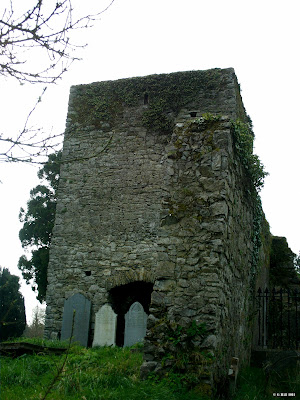Above Image: Newtown Clonbun Parish Church
Above Image: The Entrance Path
Above Image: The Tomb effigies
The immense Cathedral of Newtowntrim was part of the large Priory founded in 1202 by Simon De Rochfort, Bishop of Meath for an order of Augustinians. De Rochfort successfully petitioned the Pope to move Cathedral status from Clonard to Newtowntrim as it would be better protected by the nearby stronghold of Trim Castle.
The Cathedral dedicated to St Peter & Paul and the adjacent St John the Baptist Friary which was run by the Knights of St John of Jerusalem together became a very important ecclesiastical site but eventually fell victim to the dissolution of Churches and Abbeys in 1530's.
Sadly large parts of the transepts and nave of the Cathedral no longer exist having been removed by the16th century although there was an addition of a west facing wall. But what does remain today is quite stunning.
The site is partially covered by trees and from the road you can only see the top of the ruins jutting out. But once you have gained access the extensive size of the ruins are opened up to you.
You enter across a small stream and bridge and the first thing you encounter are the ruins of the small parish Church of Newtown Clonbun.This is notable as it contains the 16th century tomb and effigies of Sir Luke Dillon and his wife, Lady Jane Bathe. Dillon was Chief Baron of the Exchequer during Elizabeth I reign.
A short walk around the gravestones and bushes brings you to the main cathedral site. I have to say that cameras do not fully capture the grandeur of these ruins making it a real must for a visit.
The main parts of the Cathedral still stand rising to a great height and within there are some very decorative carvings in the stonework. Also to be viewed are lancet windows and a double Piscina that was used for washing communion vessels..
There are ancillary ruins also, which would have formed the domestic quarters of the Monastery. At one point you can stand on a wall and if you look one direction you can see the distant tower of Trim Castle and the other direction, St John the Baptist Friary across the bridge. Truly an historic area.
For such an important site it was almost devoid of visitors when were there. This was of course late spring so there might be more activity in the summer months. However do yourself a favour and take time to pay a visit.
To find the Newtowntrim ruins, take the R161 from Navan towards Trim. Just before you reach Trim take a left hand turn onto the R154. Drive for about 500m and you will reach a wide fork in the road. The left fork crosses the narrow stone bridge to St John the Baptist Friary and the right leads you to the ruins of the Cathedral. You can park along the wider part of the road here.























































